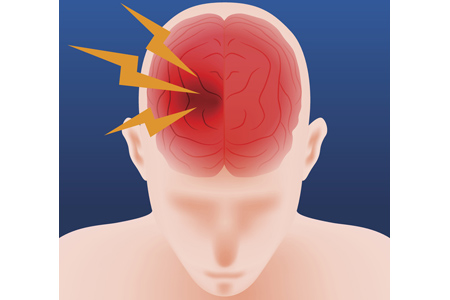By Marc Dechamps, CEO, Bioxodes
Intracerebral hemorrhage (ICH) is responsible for half of all stroke-related deaths but attracts only a fraction of the attention its better-known relative ischemic stroke gets. At Bioxodes, a clinical-phase biotech company, we faced a poignant consequence of this paradox when we struggled to recruit sufficient ICH patients into a clinical trial. Trial protocols are based largely on experiences with ischemic stroke patients, investigators noticed, which are very different from those with ICH. This real-life example underscores that not only is ICH a disease that needs better research funding, it also needs more public awareness.
When you hear of somebody hit by a stroke, chances are ischemic stroke was the culprit. Triggered by a blood clot in the brain, the condition accounts for the vast majority of strokes. It is a dangerous disease, which kills 10% of patients within the first 30 days, after an often dramatically sudden onset. Such facts may explain why ischemic stroke tends to overshadow ICH, caused by a rupture of a blood vessel in the brain, in public perception and even in medical practice. Yet despite its severity, patients with ICH are faced with limited therapeutic options and fragmented systems of care, leaving them without a clear path to recovery.
But ICH’s life in the shadows stands in stark contrast to its deadly reality. While non-traumatic ICH accounts for only approximately 10%-15% of all strokes, it is responsible for nearly half of stroke-related deaths. Mortality approaches 50% at 30 days1,2 and approximatively half of all ICH-related deaths happen within the first 24 hours3. Survivors often face severe long-term disability, with fewer than 20% achieving functional independence after six months. The burden on public health systems is large: ICH contributes to 49% of global stroke-related disability-adjusted life years (DALYs), showing the long-term impact of this devastating condition4.
The lack of an approved treatment for ICH is making this situation even more acute. Thrombolytic agents such as Alteplase, the standard of care for ischemic stroke, are not fit for purpose in ICH because of the risk of increased bleeding. ICH treatment consists largely of monitoring and stabilizing patients and, in some cases, surgery. The fact that doctors will readily describe this practice as “watch and pray” underscores the need to raise awareness, catalyze innovation, and prioritize investment in academic and clinical research.
Late Diagnoses, Restrictive I/E Criteria Present Challenges
Just how great the need for more awareness is became clear during a clinical trial in ICH we ran at Bioxodes for our drug candidate BIOX-101. This recombinant version of a small protein found in the saliva of the tick (Ixodes ricinus) displays a dual mode of action. It targets neuroinflammation and, at the same time, prevents blood clot formation, but without increasing the risk of bleeding, an essential consideration for patients with ICH.
A key observation from the trial performed in stroke units across Belgium was the unexpectedly low recruitment rate, with investigators noting a stark contrast in the hospital presentation patterns of ICH patients compared to those with ischemic stroke.
The reason was clear: ICH is often diagnosed late. Unlike ischemic stroke, which presents itself with the clear FAST symptoms (Facial drooping, Arm weakness, Speech difficulties, Time to call emergency services), symptoms for ICH are both more variable and less well known. As a result, many patients arrive at hospitals 12 to 24 hours after symptom onset — often too late to take part in clinical trials. Compounding the problem is that stroke care systems tend to be optimized for ischemic stroke, leaving ICH patients to navigate a fragmented and inconsistent care pathway. When we raised the maximum intake slot in our trial to 24 hours, which is still in line with the biology of the disease, we were able to complete recruitment rapidly.
These challenges revealed gaps in our healthcare system that need to be addressed. At the same time, the hope is that the change we made to our protocol will help investigators make future trials a success.
Accurate Diagnosis And Specialized Care Play Major Roles
Delays in treating patients are often compounded in hospitals that are insufficiently prepared to deal with stroke and where access to rapid neuroimaging, specialized care teams, and standardized protocols may be limited. In such settings, even the initial diagnosis of ICH can be delayed, narrowing the already brief window for possible trial inclusion.
While ischemic stroke benefits from well-established systems of care such as stroke codes, telestroke networks, and clearly defined pathways for thrombolysis or thrombectomy, ICH lacks those options. The absence of a universally accepted acute treatment strategy for ICH has led to inconsistent management across institutions, reducing the sense of urgency and coordination that are critical for both clinical outcomes and research participation.
Stroke units play a pivotal role in addressing these gaps. By centralizing expertise, ensuring rapid access to imaging and neurological assessment, and streamlining care processes, stroke units can significantly improve the early recognition and management of ICH. Importantly, they also enhance the infrastructure for enrolling patients in clinical trials, particularly when supported by research-trained personnel who can facilitate timely consent.
![]()
In Europe, as of 2019, there were 2,165 acute stroke units across 44 countries, a figure that represents a significant effort to centralize care and improve outcomes for stroke patients5. Yet, studies have shown that only about 30% of stroke patients are admitted to these specialized units6. In the United States, the system is similarly structured, with 2,563 certified stroke centers across the country. A study from 2019 revealed that 46% of emergency departments in the U.S. are located in hospitals with certified stroke centers, highlighting the widespread recognition of the need for specialized care in stroke management7.
An Underfunded Field Reveals Promise
Beyond patient awareness and education, a more fundamental problem remains: Treatment options for ICH are limited. This has led to a vicious circle where the absence of robust data demonstrating effective outcomes has led to a lack of interest from investors, which in turn has limited research options.
Recent developments are beginning to shift this downward spiral, with emerging clinical trials and novel therapies generating at least some promising data. One example comes from the ENRICH trial, which demonstrated good results with early minimally invasive parafascicular surgery. This approach significantly improved functional outcomes, reduced mortality, and shortened ICU and hospital stays, suggesting superior outcomes compared to medical management alone. However, the trial also highlighted an important nuance: while early clot removal can benefit some patients, it is not universally effective. These findings underscore that evacuation of the hematoma, while crucial, may not be enough to fully address neurological recovery, as secondary injury processes, such as neuroinflammation and ischemia, continue to play a role in poor outcomes. This is why therapeutics targeting thromboinflammation — such as those in development at Bioxodes — could become game-changers for ICH.
These are early signs that science may show us a way out for ICH patients. What is most needed is a joint effort to raise awareness and put ICH on the map among medical staff, investors, authorities, and the public. It is time to offer hope where, until recently, there was little.
References:
- Broderick, J.P., et al., Volume of intracerebral hemorrhage. A powerful and easy-to-use predictor of 30-day mortality. Stroke, 1993. 24(7): p. 987-93.
- Fogelholm, R., et al., Long term survival after primary intracerebral haemorrhage: a retrospective population based study. J Neurol Neurosurg Psychiatry, 2005. 76(11): p. 1534-8.
- Hemphill, J.C., 3rd, et al., The ICH score: a simple, reliable grading scale for intracerebral hemorrhage. Stroke, 2001. 32(4): p. 891-7.
- Diseases, G.B.D. and C. Injuries, Global incidence, prevalence, years lived with disability (YLDs), disability-adjusted life-years (DALYs), and healthy life expectancy (HALE) for 371 diseases and injuries in 204 countries and territories and 811 subnational locations, 1990-2021: a systematic analysis for the Global Burden of Disease Study 2021. Lancet, 2024. 403(10440): p. 2133-2161.
- Aguiar de Sousa, D., et al., Delivery of acute ischaemic stroke treatments in the European region in 2019 and 2020. Eur Stroke J, 2023. 8(3): p. 618-628.
- Prendes, C.F., et al., Burden of Stroke in Europe: An Analysis of the Global Burden of Disease Study Findings From 2010 to 2019. Stroke, 2024. 55(2): p. 432-442.
- Zachrison, K.S., et al., Estimated Population Access to Acute Stroke and Telestroke Centers in the US, 2019. JAMA Netw Open, 2022. 5(2): p. e2145824.
About The Expert:
 Marc Dechamps is a biologist with more than 35 years of experience in the pharmaceutical industry, including at GSK and ViiVHealthcare. His expertise in developing new products ranges from infectious diseases, immunological disorders, oncology, and CNS disorders to vaccines. In 2016, Marc founded XMF Consulting, a company that supports biotech and biopharma businesses with strategic advice and management leadership. He has served as managing director of Delphi Genetics, a CDMO, and interim CEO of eTheRNA Immunotherapies, an mRNA biotech firm. Next to his busy role as Bioxodes CEO, Marc serves as president of the board of Investsud Tech (group InvestSud) and as board member of HealthTech for Care (HT4C). He is a co-academic director for the advanced master’s in biotech & medtech ventures at the Solvay Brussels School of Economics & Management, and he recently joined Ose Immunotherapeutics as an independent board member.
Marc Dechamps is a biologist with more than 35 years of experience in the pharmaceutical industry, including at GSK and ViiVHealthcare. His expertise in developing new products ranges from infectious diseases, immunological disorders, oncology, and CNS disorders to vaccines. In 2016, Marc founded XMF Consulting, a company that supports biotech and biopharma businesses with strategic advice and management leadership. He has served as managing director of Delphi Genetics, a CDMO, and interim CEO of eTheRNA Immunotherapies, an mRNA biotech firm. Next to his busy role as Bioxodes CEO, Marc serves as president of the board of Investsud Tech (group InvestSud) and as board member of HealthTech for Care (HT4C). He is a co-academic director for the advanced master’s in biotech & medtech ventures at the Solvay Brussels School of Economics & Management, and he recently joined Ose Immunotherapeutics as an independent board member.
